The coating is applied pyrolytically during the production process and and is therefore permanently bonded to the glass surface. It is activated by UV rays from daylight and thus develops an antimicrobial effect against enveloped viruses on glass surfaces. It can also double the effectiveness of the UV disinfection process. Pilkington SaniTise thus contributes to a hygienic and hygiene-oriented design of the environment.
How the new glass works
As soon as Pilkington SaniTise is exposed to the UV radiation of natural daylight, its antimicrobial effectiveness is significantly increased compared to uncoated glass.
See also this article:
Health through architecture and design
The new glass is now available in a range of colours and dimensions and in thicknesses from 3.2 to 10 mm. According to the developers, the highly resistant online coating lasts the entire life of the glass and can be tempered, laminated, bent or processed into insulating glass units using standard techniques.

Pilkington
Once activated, Pilkington SaniTise is also oleophobic (i.e. resistant to fingerprints) and easier to clean than normal glass. It is compatible with commercially available cleaning products and highly resistant to corrosion and chemical damage, as the developers point out.
Wide range of applications
According to the manufacturer, independent external tests have shown that Pilkington SaniTise provides additional protection for all shared/frequently touched surfaces exposed to natural UV light, such as













